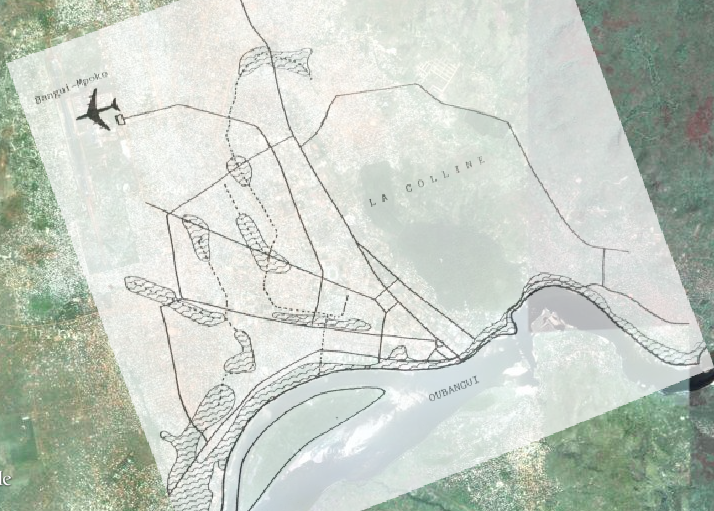- How is your city depicted on the web? Provide the U.R.L.’s of five sites that offer different views of your city’s popular life.
- Discuss one building of popular or political importance in your city. Describe its setting. Provide a photograph of this building (with label).
- Create a polygon and point to identify the site of this structure and the area in which it is located. Provide a screenshot indicating the location of your building in Google Earth.
See, this is where making a blog about Bangui gets (more) difficult. The problem with describing how Bangui is depicted on the Internet is that, by and large, it isn’t. The Central African Republic’s 123,800 Internet users make up only about 2.5% of the country’s population (Internet World Stats). Thus, it should come as no surprise that to find websites related to popular life in Bangui is exceedingly frustrating. Here’s what I found:
- Journal de Bangui: A Central African newspaper, Le Journal de Bangui has something resembling the “standard” array of sections expected in a periodical—Société, Musique, Arts, etc.—as well as news. The society- and culture-related sections are useful for getting a peak into popular life: articles about the National Central African Theater Troupe and a book about urban development by a Central African expatriate remind the reader that such things exist even in a city as decrepit and poor as Bangui, though they also make one wonder how accessible they are to the general public.
- “La Lettre de C.B.M.”: “La Lettre de C.B.M.” provides political and social commentary about happenings in Bangui and the Central African Republic. It is not a newspaper, and so has no obligation to be unbiased; the result is that the perspective is often quite jaded, ending posts with phrases like, « Oh Centrafrique, jusqu’à quand ? » (“Oh, Central Africa, how long?”)
- “Letters to Bangui”: A Swedish doctoral student spent nine weeks in the Central African Republic researching security sector reform, and maintained a blog about her experiences. They give some insight into the positive and negative aspects of life in Bangui.
- “Bangui, Capital of Misery”: Disregard this journal’s affiliation with an anarchist group, and it provides a telling, almost comical, account of poverty and bureaucratic corruption in the C.A.R., as experienced by a group of Irish tourists.
- Le Confidant: I didn’t want to use another newspaper, but you underestimate the utter lack of online material about Bangui. This site, notable for its wretched design, also has several sections about popular life that appear to be updated about once a week. What is interesting to note is that there appears to be little overlap between the coverage of Le Confidant and Le Journal de Bangui.
Sô Zowa Laâ and BanguiWeb are good aggregations of links, images and information. The former is made for the Central African diaspora, and the latter is something like a travel guide, on the off-chance that someone wants to go on a relaxing vacation to Bangui (not recommended, by the way).
 |
| In the architecture of Bangui’s Palais d’Assemblée Nationale, one can see the grandeur envisioned by its French architects; in the overgrown lawn, the collapse of public services in the city is also readily apparent. Image: http://img4.hostingpics.net |
There are several interesting buildings in Bangui—though, admittedly, fewer than in a lot of other cities. Here, let’s talk about the National Assembly building. Built between 1953 and 1960 by French architects Cazaban, Legrand, Janin and Sarkovitch, it was completed just in time for independence to house the 140 deputies of the Central African Republic’s unicameral legislature. It was designed in angular, modernist style with efficient ventilation in mind, and the architects deliberately used a variety of local materials in its construction (Christin and Filliat 268).
The Palais d’Assemblée Nationale is not in the city center; this area was filled to capacity by the French long before they even considered giving Ubangi-Shari any measure of self-governance. It is on the outskirts of what was the “European city” of the colonial era, on a thin strip of planned city north of the central roundabout between the densely packed ethnic quarters of Mandaba, Fou, Outala, Banga and Miskine (Villien 54).
 |
| The National Assembly building’s location in Bangui, with the surrounding neighborhoods labeled. |
References
“Africa Internet Facebook Usage and Population Statistics.” Internet World Stats. 10 Feb 2012. Web. 26 Feb 2012 <http://www.internetworldstats.com/africa.htm#cf>.
Christin, Olivier, and Armelle Filliat. “Destin Des Villes De Pouvoir.” Architectures Françaises Outre-Mer. Ed. Pierre Mardaga. Liège: Institut Français d’Architecture, 1992. 259–271. Print.
Villien, François, et al. Bangui, Capitale d’un Pays Enclavé d'Afrique Centrale : Étude Historique Et Géographique. 4 Vol. Talence: Centre de Recherches sur les Espaces Tropicaux, Institut de Géographie, Université de Bordeaux III, 1990. Print. Pays Enclavés.





